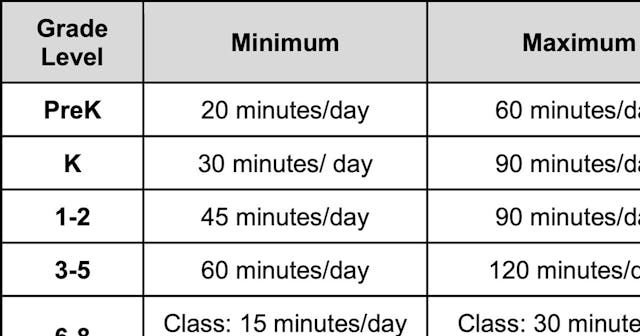Chart Shows The Hours A Child Should Be Homeschooling By Grade

The chart outlines the minimum and maximum number of hours (or minutes) a child should spend homeschooling
While the nation is practicing social distancing to slow the coronavirus pandemic, millions of parents have spent the last several weeks learning how to homeschool as they go. Most of us didn’t exactly sign up for this, and suffice to say, it’s a steep learning curve. As some of us watch our kids toil for hours while trying to complete their homeschooling each day, it’s comforting to know that experts say there is a maximum (and minimum) amount of time kids should be homeschooling each day.
Thanks to a chart created by the Illinois State Board of Education and released as part of their “remote learning recommendations,” we can try to gauge how much time our kids should be logging into Google Classroom and hitting the books from home. It might be a lot less time than you think:
Illinois Board of Education
My kids are in middle school and this chart about adds up for us, but I know friends with younger kids who are definitely spending a lot more time on homeschooling each day than the Board is recommending. This is useful information for us parents to have, considering most of us probably aren’t actual teachers. Pushing a younger kid for too long will only result in frustration for everyone, so it’s good to see that elementary school children shouldn’t be spending six hours every day on their homeschooling work.
Of course, every state has their own board of education and can issue guidelines independently, but this chart can serve as a baseline to help understand whether your kids are doing too much, not enough, or just the right amount of homeschooling work.
In addition to the chart, the Illinois board offered ideas for activities kids could do to enrich not just their academics, but their physical health and family relationships.
Ideas include puzzles, writing stories, dancing, coloring, gardening, and telling jokes to family members. It’s important to remember as we navigate this homeschooling landscape that “in-person” school includes many moments that aren’t just staring at the board, doing worksheets, and taking notes. If your kids want to start up a garden, that can make a pretty amazing little science lesson. If your tweens want to learn some TikTok dances for 30 minutes? Hello, physical education addendum. We can get creative and fill the days with fun and memories along with meeting all the requirements set forth by their wonderful teachers.
This is all new and uncharted, so it’s great when resources like this are available for parents to help guide us through.
This article was originally published on